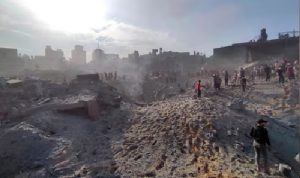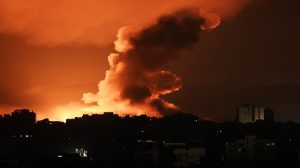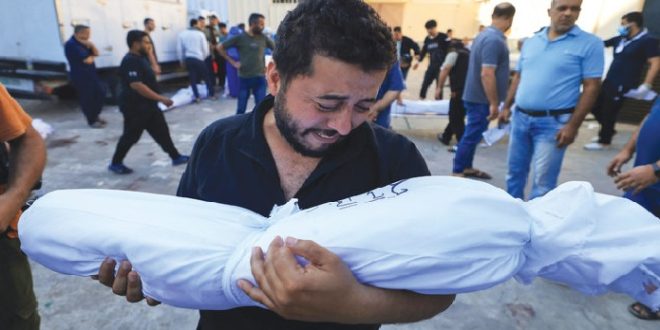02-11-2023
GAZA CITY: The ceiling collapsed on little Yusuf Musa as his house in a south Gaza neighborhood was hit directly by an Israeli missile. It was Yusuf’s father who identified his dead son in the hospital where he works as a doctor (he has not gone home in the last three weeks); the hospital authorities felt it would be better if Yusuf’s mother did not see her son’s disfigured remains.
 Yusuf’s last words to his mother had not been heavy with the import of a final farewell; on the contrary, they glimmered with the easy certainty of a familiar routine embellished with love. “Mom, we [he and his brother] want to have dinner…” is what he said when his life took a different turn, towards death.
Yusuf’s last words to his mother had not been heavy with the import of a final farewell; on the contrary, they glimmered with the easy certainty of a familiar routine embellished with love. “Mom, we [he and his brother] want to have dinner…” is what he said when his life took a different turn, towards death.
Gaza has become a graveyard of children, UN Children’s Fund (UNICEF) spokesman James Elder stated during a news briefing in Geneva on October 31.
It is an unspeakable situation;
On October 31, the Gaza health ministry issued a statement that of the 8,525 Palestinians killed in the past three weeks, 2,187 were women and 3,542 were children. That means 41% of those killed so far have been children.
Over 6,000 children have been injured and about 900 children are believed to be under the rubble.
Israeli air strikes have killed over 100 children in Gaza every day since October 7. (In the first six days alone, Israel dropped 6,000 bombs in Gaza, almost equaling the number of bombs dropped by the US in Afghanistan in one year.) UNICEF puts the figure of children killed and injured daily at over 400.
According to Save the Children, the number of casualties among children in Gaza in three weeks “surpasses the annual number of children killed across the world’s conflict zones since 2019”.
 Anaesthesia shortages have meant that doctors have had to carry out amputations on children without pain relief, according to Doctors Without Borders.
Anaesthesia shortages have meant that doctors have had to carry out amputations on children without pain relief, according to Doctors Without Borders.
The complications caused by dehydration as Gaza now has access to a mere 5% of its water requirements puts the lives of infants at risk.
Children under 18 comprise half the population of 2.3 million in Gaza.
There is no end to the images of grief that are being captured 24/7. Children by themselves at hospitals after air strikes, separated from their families. Men collecting the bodies of their children wrapped in bloodstained white hospital sheets, cradling them in their arms or holding them aloft, trying to shield the women from such unimaginable sights. The furrows on their faces indicating that the grief, like a thorn embedded deep in the flesh, is here to stay.
These deaths are not collateral, caused by strikes intended for another target but landing on people’s houses. The strikes are deliberate, as the intensive targeting of residential neighborhoods, schools and hospitals indicates. The Israeli intent of collective punishment has been made clear by its actions of cutting off water, power, fuel and food, followed by pulverizing airstrikes and now a ground offensive. (Int’l Monitoring Desk)
 Pressmediaofindia
Pressmediaofindia




